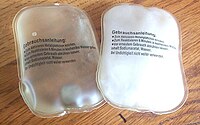
Photo from wikipedia
Abstract Using phase change materials (PCMs) for thermal energy storage is an effective technique of energy management to address the mismatch problems between energy supply and demand. Shape-stabilized composite PCMs… Click to show full abstract
Abstract Using phase change materials (PCMs) for thermal energy storage is an effective technique of energy management to address the mismatch problems between energy supply and demand. Shape-stabilized composite PCMs could efficiently solve their leakage problem during the solid-liquid phase change process, which have been widely used and extensively reviewed in literature. However, those reviews mainly focused on microencapsulated PCMs and the broad properties and applications of composite PCMs but paid little attention to the nanoporous shape-stabilized composite PCMs. The nanoporous shape-stabilized composite PCMs do solve the leakage problem and show excellent chemical stability and thermal cycling stability, but most of their enthalpy values were much lower than that of the pure PCMs component. So in this review we have highlighted recent progress in the research of nanoporous shape-stabilized PCMs, such as the design concept of porous support, fabrication and characterization techniques, and especially the nanoconfinement effects of the porous support on the thermal properties of the PCMs confined in the nanopores. Finally, we have provided a brief outlook of the future challenges and potential prospects of nanoporous shape-stabilized composite PCMs. This review paper will help to explore and develop better nanoporous shape-stabilized composite PCMs for practical applications and offer basic understanding of nanoconfinement effects on thermal properties.
Journal Title: Nano Energy
Year Published: 2018
Link to full text (if available)
Share on Social Media: Sign Up to like & get
recommendations!